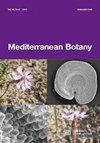Ethnobotanical investigation on medicinal plants used by local populations in Tlemcen National Park (extreme North West Algeria)
IF 0.7
4区 生物学
Q3 PLANT SCIENCES
引用次数: 8
Abstract
Medicinal plants are currently used by local populations to treat different diseases around the world. In the present study, the local knowledge of medicinal plants used by indigenous populations living in the Park of Tlemcen (North-West Algeria) has been documented. A total of 254 informants with a strong ethnomedicinal knowledge living in the national park of Tlemcen were interviewed by using a questionnaire. Data collected was analyzed using quantitative indices such as the ethnobotanicity index (EI), use value (UV), and Informant Consensus Factor (FIC). 109 species belonging to 54 families were identified and used by indigenous populations to treat different diseases. The most frequent families were lamiaceae (15.5%), asteraceae (11.9%), and rosaceae (5.5%). Roots, rhizomes or tubers were the most used part for medical care (37.6%), followed by leaves (33.6%), other aerial parts (16%), fruits (8%), flowers (1.6%), and seeds (3.2%). Regarding modes of preparation, we noticed that decoction (40.4%) and infusion (28.5%) were the most predominant. Moreover, Thymus lanceolatus (UV=0.96), Origon glandulosum (UV=0.96) and Ammoides verticillata (UV=0.94) were the most frequently used species. FIC values ranged from 0.65 to 0.98. The highest FIC were recorded for reproductive and sexual disorders (0.98), respiratory tract diseases (0.98), cardiovascular system disease and blood disorders (0.94), digestive disorders (0.93), and general health (0.93). A variety of species are used to treat several ailments. Recorded species with high UV should be prioritized for conservation and subjected to further phytochemical and pharmacological studies.阿尔及利亚西北部特莱姆森国家公园当地居民使用药用植物的民族植物学调查
药用植物目前被当地居民用于治疗世界各地的不同疾病。在本研究中,对生活在特莱姆森公园(阿尔及利亚西北部)的土著居民使用的药用植物的当地知识进行了记录。采用问卷调查法对居住在特莱姆森国家公园的254名具有较强民族医学知识的被调查者进行了访谈。采用民族植物性指数(EI)、使用价值(UV)和信息者共识因子(FIC)等定量指标对收集到的数据进行分析。已鉴定出属于54科的109种,并被土著居民用于治疗不同的疾病。最常见的科为紫堇科(15.5%)、菊科(11.9%)和蔷薇科(5.5%)。根、根茎或块茎是医疗保健中使用最多的部分(37.6%),其次是叶子(33.6%)、其他地上部分(16%)、果实(8%)、花(1.6%)和种子(3.2%)。在制备方式方面,我们注意到煎煮(40.4%)和输液(28.5%)是最主要的。其中,胸腺(Thymus lanceolatus) (UV=0.96)、腺原(Origon glandulosum) (UV=0.96)和轮状氨(Ammoides verticillata) (UV=0.94)是最常被利用的物种。FIC值在0.65 ~ 0.98之间。FIC最高的是生殖和性疾病(0.98)、呼吸道疾病(0.98)、心血管系统疾病和血液疾病(0.94)、消化系统疾病(0.93)和一般健康(0.93)。各种各样的品种被用来治疗几种疾病。已记录的高紫外线物种应优先保护,并进行进一步的植物化学和药理研究。
本文章由计算机程序翻译,如有差异,请以英文原文为准。
求助全文
约1分钟内获得全文
求助全文
来源期刊

Mediterranean Botany
Agricultural and Biological Sciences-Plant Science
CiteScore
2.40
自引率
10.00%
发文量
30
审稿时长
12 weeks
期刊介绍:
Mediterranean Botany (ISSNe 2603-9109), formerly Lazaroa, is a biannual journal that publishes original research studies in the field of Botany including plant systematics, vegetation ecology, biogeography, evolutionary biology, ecophysiology, community ecology, ethnobotany and conservation biology on Mediterranean biomes but also in interacting areas.
Mediterranean Botany is an OPEN ACCESS Journal, free of charges for any published article.
 求助内容:
求助内容: 应助结果提醒方式:
应助结果提醒方式:


